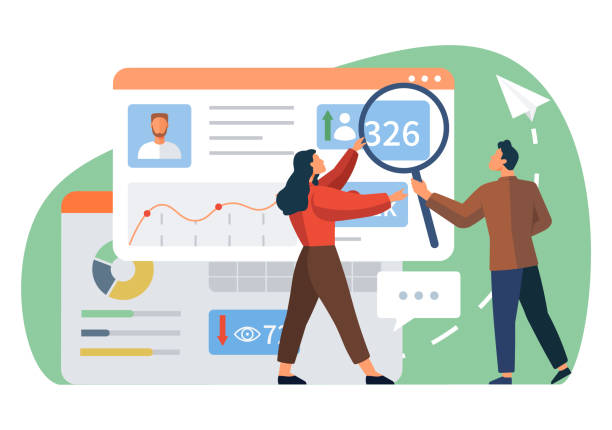Introduction and Importance of Secure Website Design in the Online Space

In today’s fast-paced world, an online presence for businesses and individuals is not an option, but a necessity.
However, as the internet provides countless opportunities, it also brings new security challenges and threats.
#Secure_Website_Design is no longer a luxury feature, but a fundamental basis for maintaining user trust, protecting sensitive data, and ensuring the sustainability of your online business.
The importance of this issue is such that the smallest security vulnerability can lead to the loss of personal information, damage to brand reputation, and even irreparable financial losses.
For this reason, anyone or any organization planning to operate in the web space must, from the outset, incorporate the principles of web cybersecurity into their development process.
This not only includes protection against external attacks but also covers proper access management, regular updates, and employee training.
Websites, due to storing customer information, conducting financial transactions, and providing sensitive services, have become attractive targets for cybercriminals.
The goal of this article is to provide a comprehensive and specialized view on why and how to design a secure website. We will examine various aspects of this topic, from understanding common threats to implementing preventive solutions and responding to potential incidents.
This guide will help you create a website resilient to cyber attacks with a deeper understanding of web application security.
We intend to pave your path to information security on the web by providing educational and explanatory content, and assist you in this complex journey with guidance tips.
Website security is not a destination but a continuous journey that requires constant attention and updates.
Ignoring it can lead to legal penalties, loss of valuable data, and complete destruction of customer trust, which will be very difficult or even impossible to regain.
Are you bothered by losing customers because of your online store’s outdated appearance or slow speed? Rasaweb’s expert team solves these problems with professional online store design!
✅ Increase customer trust and your brand’s credibility
✅ Stunning speed and excellent user experience
Get a free consultation with Rasaweb now ⚡
Understanding Common Threats in the Online Space and Their Impact on Website Security

To best implement a #Secure_Website_Design, we must first understand the enemy.
The online world is full of diverse and complex threats, each of which can jeopardize your website.
Understanding these threats and how they operate is the first and vital step in protecting your website.
Among the most common attacks are SQL Injection attacks, where attackers gain access to sensitive information by injecting malicious code into database inputs.
This type of attack can lead to the theft, alteration, or even deletion of data in the database.
Cross-Site Scripting (XSS) attacks also target users by injecting malicious scripts into web pages and can steal their session information, manipulate cookies, or redirect users to phishing pages.
Another serious threat is DDoS (Distributed Denial of Service) attacks, which overwhelm the website’s server with a huge volume of fake traffic, disrupting access for legitimate users.
These attacks not only lead to service unavailability but can also cause significant financial losses due to lost sales or services.
Also, Phishing, which primarily targets users and tricks them into entering their login information on fake websites, can indirectly impact your website security and lead to unauthorized access to actual user accounts.
Malware and ransomware are also continuous threats that can damage website data or lock them, demanding money for their release.
Understanding this wide range of threats is essential for anyone responsible for secure web development.
The analytical content of this section will help you identify potential vulnerabilities in your website and prepare to counter them. This includes analyzing recent cyber attack patterns and predicting future trends.
For example, Zero-day attacks, which are undetectable until security patches are discovered and released, are always a major challenge and require advanced detection approaches.
To counter such threats, you must have a multi-layered approach to web security that includes continuous software updates, the use of powerful firewalls, and continuous monitoring of website traffic.
This is a specialized discussion that requires precision and high awareness of the latest security developments.
Basic Principles of Web Security and Implementing Secure Website Design

To begin a #Secure_Website_Design, it is necessary to be familiar with the fundamental principles of web security.
These principles act as the main pillars of a secure website construction and will guide us in the process of web security.
The first principle is the use of HTTPS.
HTTPS (Hypertext Transfer Protocol Secure) is a secure communication protocol that prevents eavesdropping, tampering, or forgery of information during transmission by encrypting data.
This is done using SSL/TLS certificates and not only ensures data security but also positively impacts website credibility in the eyes of users and search engines, aiding SEO ranking.
The second principle is rigorous Input Validation.
Most common attacks such as SQL Injection and XSS are carried out through invalid or malicious input data.
Therefore, any data received from users must be carefully examined, filtered, and sanitized to prevent the execution of unwanted code or the injection of malicious information.
The third principle is proper Session Management.
Sessions should have a limited lifespan, and session tokens should be generated randomly and unpredictably to prevent attacks such as Session Hijacking.
The fourth principle is strong authentication and access management.
The use of complex passwords, Two-Factor Authentication (2FA), and Role-Based Access Control (RBAC) to limit user access to the minimum necessary (Principle of Least Privilege) is essential, ensuring each user only accesses resources required for their tasks.
In the educational and guidance section of this chapter, we provide a table of common vulnerabilities and their countermeasures for secure website design. This table will help you better understand the existing challenges and solutions and enable you to apply them in your secure website configuration and follow best security practices.
| Vulnerability Type | Brief Description | Countermeasures |
|---|---|---|
| SQL Injection | Injecting malicious SQL code to access the database | Using Prepared Statements/Parameterized Queries, Input Validation |
| Cross-Site Scripting (XSS) | Injecting malicious scripts into web pages to attack users | Output Encoding, Content Security Policy (CSP), Input Sanitization |
| Broken Authentication | Weaknesses in authentication mechanisms and session management | Using strong passwords, 2FA, secure session management, rate limiting |
| Insecure Deserialization | Insecure deserialization of data leading to remote code execution | Using secure data formats, monitoring Deserialization, exception monitoring |
| Security Misconfiguration | Improper configuration of servers, frameworks, and applications | Removing unnecessary features, applying hardening, using secure templates |
The Developer’s Role in Ensuring Secure Website Design

Developers play a critical and undeniable role in the #Secure_Website_Design process.
They are the first line of defense against cyber attacks, and their decisions at every stage of the Software Development Life Cycle (SDLC) directly impact website security.
A developer committed to secure coding principles must consider web security architecture from the outset, rather than adding security to the project in the final stages.
This approach, known as “Security by Design,” means integrating security considerations into design, development, testing, and deployment, and should become an integral part of the development culture.
Developers must stay up-to-date on the latest known vulnerabilities and threats.
Organizations like OWASP (Open Web Application Security Project) provide valuable resources, including a list of the top 10 web vulnerabilities, which developers should master.
Using secure frameworks and libraries is another important task for developers.
Many modern frameworks provide built-in mechanisms to counter common attacks, but their correct use and proper configuration require awareness and knowledge.
Also, writing clean, maintainable, and debugged code helps reduce the attack surface and minimizes the likelihood of security errors.
Conducting Code Reviews by peers can also help identify weaknesses before deployment.
In the specialized and guidance section of this chapter, it is emphasized that developers should participate in continuous cybersecurity training. These trainings can include secure coding courses, familiarity with static (SAST) and dynamic (DAST) code analysis tools, and understanding concepts related to authentication, validation, and session management.
Active participation in security tests and collaboration with security teams are also of high importance.
Without a developer’s commitment to creating a secure digital environment, any effort to design a secure website will be incomplete.
Creating a secure website requires a security mindset among every member of the development team, from the ideation phase to maintenance and support.
Are you tired of your company’s website not getting the visibility it deserves and losing potential customers? Rasaweb solves this problem permanently with professional and effective website design!
✅ Significantly increase brand credibility and customer trust
✅ Unparalleled user experience for your customers
⚡ Contact us now for a free consultation!
Advanced Security Tools and Techniques for Secure Web Development

To achieve a high level of #Secure_Website_Design, beyond the basic principles, advanced security tools and techniques are needed.
These tools help you discover vulnerabilities, prevent attacks, and continuously improve your website security.
One of these vital tools is Web Application Firewalls (WAF).
WAFs sit between your website and the internet, analyzing incoming and outgoing traffic to identify and block common attacks such as SQL Injection, XSS, and DDoS.
They can act as an additional defensive layer and even neutralize attacks that exploit Zero-day vulnerabilities.
Web Vulnerability Scanners such as Nessus or Acunetix also play an important role.
These scanners automatically test your website for known weaknesses, misconfigurations, and software vulnerabilities.
The use of Intrusion Detection Systems (IDS) and Intrusion Prevention Systems (IPS) for monitoring network traffic and identifying suspicious activities is also recommended.
IDSs alert, while IPSs can actively block attacks and provide a form of automatic response to threats.
Also, using static (SAST) and dynamic (DAST) code analysis tools during the development process can help identify vulnerabilities in the early stages and reduce debugging costs.
In the specialized and explanatory section of this chapter, we also address the importance of using Security Information and Event Management (SIEM) solutions. SIEM systems collect, correlate, and analyze security logs from various sources to provide a comprehensive view of the website’s security posture and quickly detect security incidents.
Furthermore, the use of Content Delivery Networks (CDNs) with security features, such as Cloudflare or Akamai, not only increases website loading speed but also significantly contributes to increasing your website’s security by providing DDoS protection and internal WAF.
All these tools combined create a strong defensive layer for secure website design and enable you to identify and manage threats before they become a major problem.
Penetration Testing and Continuous Security Assessments for Web Cybersecurity

After implementing security principles and tools, the next crucial step is #Penetration_Testing and continuous security assessments.
A #Secure_Website_Design is never finished; it requires continuous review and updates.
Penetration Testing, often referred to as “ethical hacking,” is a process where security professionals identify weaknesses and vulnerabilities in your website using methods similar to real attackers.
These tests can include various scenarios, such as attempting unauthorized access, exploiting known vulnerabilities, and social engineering, with the goal of discovering security gaps before real attackers find them.
The results of penetration testing provide a comprehensive report of discovered vulnerabilities, their severity, and proposed solutions for addressing them.
These reports are invaluable for improving website security and ensuring web cybersecurity and should be used as a roadmap for security remediation.
In addition to penetration testing, regular security audits, vulnerability scanning, and code reviews are essential parts of continuous security assessments.
These assessments should be performed periodically and after any major changes to the website (such as adding new features, updating frameworks, or changing infrastructure) to ensure no new vulnerabilities have been introduced.
The code review process can also help identify logical and security bugs that might not be detected by automated tools.
The specialized and guidance section of this article emphasizes that the security assessment process should include a Gray-box approach (a combination of Black-box and White-box). In Black-box testing, the tester has little internal information, similar to a real attacker, and attempts to penetrate the system based on external information.
In White-box testing, the tester has full access to the source code and infrastructure, allowing for more detailed examination and discovery of deeper vulnerabilities.
The Gray-box approach, combining these two, yields the best results for discovering complex vulnerabilities in secure web development and provides a realistic view of the website’s security posture.
This continuous and proactive approach helps you maintain a stable and reliable secure website design.
Crisis Management and Security Incident Response in Secure Website Design

Even with the strongest #Secure_Website_Design, the probability of security incidents never reaches zero.
Therefore, having a well-defined plan for #Crisis_Management and #Security_Incident_Response is of paramount importance.
These plans help you react quickly and effectively in the event of a cyber attack, minimize damages, and rapidly restore your website to normal operation.
An incident response plan typically includes the stages of identification, containment, eradication, recovery, and lessons learned, each playing a vital role in effective crisis management.
Incident identification is the first step and involves continuous monitoring of logs, intrusion detection systems, and user reports.
Any suspicious activity or unusual pattern must be investigated immediately.
Following identification, the containment phase begins, aiming to prevent the spread of the attack and protect affected areas.
This may involve disconnecting infected servers, applying emergency patches, changing passwords, or isolating compromised systems.
Eradication means finding and eliminating the root cause of the incident to prevent its recurrence in the future.
This phase includes detailed analysis of digital evidence (Digital Forensics) to understand how the attack occurred.
In this news and analytical section, we emphasize the importance of training the Incident Response Team. Members of this team should be aware of their roles and responsibilities and regularly conduct incident simulation exercises (Tabletop Exercises) to prepare for real-world scenarios.
The NIST SP 800-61 Computer Security Incident Handling Guide is a reputable resource for developing such plans.
The recovery phase involves restoring systems and data from secure and reliable backups and should be carried out with precision and thorough testing.
Finally, lessons learned means thoroughly reviewing the incident, identifying weaknesses in processes and systems, and implementing necessary changes to improve web security architecture.
This proactive and reactive approach is key to maintaining the security and stability of your website in the long term and ensures that even after an attack, your website will be able to continue operating.
| Phase | Description | Key Actions |
|---|---|---|
| Preparation | Establishing policies, procedures, and an incident response team before a crisis occurs | Team training, tool preparation, designing secure website design from scratch |
| Identification | Detecting a security incident and gathering initial information | Monitoring logs, user reports, analyzing alerts and suspicious activities |
| Containment | Preventing further damage and controlling the incident to limit losses | Disconnecting, isolating infected systems, blocking attackers |
| Eradication | Finding and eliminating the root cause of the attack and ensuring complete cleanup | Forensic analysis, patching, removing malware and vulnerabilities |
| Recovery | Restoring systems and services to normal and operational status | Using reliable backups, testing systems, careful monitoring after recovery |
| Lessons Learned | Reviewing the incident to improve future processes and prevent recurrence | Post-incident meeting, updating security policies and procedures |
User Education and Security Culture in Secure Website Configuration

One of the most important yet overlooked aspects of #Secure_Website_Design is the human element.
Even the most advanced security systems are vulnerable to human error.
Therefore, #User_Education and #Security_Culture are crucial for any website aiming for secure website configuration and long-term web cybersecurity.
These trainings should include both internal employees and end-users of the website, as both groups can inadvertently become security weaknesses and be exposed to social engineering attacks.
For internal staff, training should cover topics such as identifying phishing and spear-phishing emails, the importance of using strong and unique passwords for each service, how to manage sensitive information, and the necessity of reporting any suspicious activity to the security team.
The use of Two-Factor Authentication (2FA) and organizational password management should become a standard.
They should also be informed about the dangers of downloading unauthorized software from untrusted sources or clicking on unknown and suspicious links.
Conducting regular training sessions and phishing attack simulations can help increase employee vigilance.
In the engaging and educational section of this article, the critical role of end-users is also addressed. Websites that allow user registration and login should encourage their users to use strong passwords and ask them not to share their login information with others.
Providing simple and understandable guides on maintaining online privacy, how to identify fake websites (phishing), and the dangers of using public Wi-Fi networks can help increase user awareness and reduce the risk of phishing and social engineering attacks.
Establishing a strong security culture means that security is understood as a shared responsibility by everyone involved in the website’s ecosystem, not just the IT team.
A secure website design that is not accompanied by education and awareness will never be completely successful and will always have human vulnerabilities.
Do you have an online store, but your sales are not what you expect? Rasaweb solves your problem permanently with professional online store designs!
✅ Significant increase in conversion rates and sales
✅ Unparalleled user experience for your customers
⚡ Click now for a free consultation with Rasaweb!
The Future of Secure Website Design and New Trends in Web Security

The world of #Secure_Website_Design is constantly evolving.
As new technologies emerge, cyber threats also become more complex and sophisticated.
Therefore, to maintain #Website_Security in the future, it is essential to be familiar with new trends in web security and prepare for them.
One of the most important future trends is the increasing use of Artificial Intelligence (AI) and Machine Learning (ML) in cybersecurity.
These technologies can identify complex attack patterns, discover unknown threats (Zero-day), and automatically respond to security incidents, significantly reducing response time and improving detection accuracy.
Cloud Security has also become a critical area, as businesses are increasingly turning to cloud platforms to host their websites and data.
Securing data and applications in cloud environments requires specific approaches and tools, including proper configuration of cloud services, access management, and continuous monitoring.
Blockchain and Distributed Ledger Technologies (DLT) also offer significant potential for enhancing data security and authentication and could play an important role in future web security architecture, especially in areas such as decentralized authentication and data integrity protection.
In the analytical and news section of this chapter, we examine the concept of “Zero Trust Security”. This concept is based on the idea that no user or device, whether inside or outside the network, should be automatically trusted, and all requests must be authenticated and authorized, even if they originate from within the network.
This strict approach can significantly increase the level of security in secure website design and neutralize insider threats.
Also, there are growing concerns about data privacy and regulations such as GDPR (General Data Protection Regulation) and CCPA (California Consumer Privacy Act) that require developers to adhere to the highest standards of data protection in secure web development.
Responding to these challenges is key to ensuring a secure digital environment for the future.
It is question-provoking whether we can always stay one step ahead of attackers?
The Importance of Continuous Updates and Security Maintenance for Secure Websites

One of the most fundamental pillars of #Secure_Website_Design and maintaining #Website_Security over time is #Continuous_Updates and #Security_Maintenance.
A static and unchanged website quickly becomes an easy target for attackers.
The software used on websites, from the server operating system to the Content Management System (CMS), frameworks, plugins, and even JavaScript libraries, all may have vulnerabilities that are discovered over time and through the efforts of security researchers.
The developers of these applications regularly release Security Patches and updates to address these vulnerabilities.
Ignoring these updates means leaving backdoors open for attackers to easily gain access to your system.
This is especially critical for websites using popular CMSs like WordPress, Joomla, or Drupal, as these platforms are attractive targets for automated attacks due to their widespread use, and their vulnerabilities are quickly exploited.
Each update not only fixes bugs but may also add new security features.
In the explanatory and guidance section of this chapter, it is emphasized that security maintenance includes the following: Regularly updating the CMS core and all plugins/themes (only from trusted sources and with compatibility checks), updating the operating system and server software (such as PHP, MySQL, web servers), periodically reviewing server logs to identify suspicious and unusual activities, and regularly performing backups (Backup) of all website data and code. These backups should be stored in a secure location off the main server and be testable to allow for full website recovery in the event of serious attacks like ransomware or system failures, without data loss.
Establishing and adhering to a regular security maintenance program ensures that your secure website design remains secure in the long term and supports sustainable web security.
Frequently Asked Questions
| Question | Answer |
|---|---|
| 1. What does secure website design mean? | Secure website design means creating a website that is resistant to cyber attacks and protects user and server data. |
| 2. Why is security important in website design? | To prevent data breaches, maintain user privacy, preserve user trust, and prevent financial and reputational losses. |
| 3. What are the most common web vulnerabilities? | SQL Injection, Cross-Site Scripting (XSS), Cross-Site Request Forgery (CSRF), Broken Authentication, and Security Misconfiguration. |
| 4. How can SQL Injection be prevented? | By using Prepared Statements / Parameterized Queries, ORMs, and Input Validation. |
| 5. What is the role of HTTPS and SSL/TLS in site security? | HTTPS encrypts the communication between the user’s browser and the server using the SSL/TLS protocol, preventing eavesdropping and data tampering. |
| 6. What actions should be taken to prevent XSS attacks? | Input validation, Output Encoding to prevent malicious code execution, and using Content Security Policy (CSP). |
| 7. What does a strong password policy include? | Mandating the use of long passwords, a combination of uppercase and lowercase letters, numbers, and special characters, and preventing reuse. |
| 8. How does Two-Factor Authentication (2FA) help with security? | Even if a user’s password is compromised, the attacker cannot log into the account without access to the second authentication factor (such as an SMS code or an app). |
| 9. What is a Web Application Firewall (WAF) and what is its use? | A WAF is a firewall that monitors and filters HTTP traffic between a web application and the internet to prevent common web attacks such as SQL Injection and XSS. |
| 10. Why is regular updating of software and libraries important? | Updates often include security patches to fix discovered vulnerabilities. Failure to update can expose the site to new attacks. |
And other services of Rasaweb Advertising Agency in the field of advertising
Smart Sales Automation: An innovative service for increasing website traffic through marketing automation.
Smart Marketplace: A creative platform for improving customer acquisition with intelligent data analysis.
Smart Advertising Campaign: An innovative service for increasing digital branding through key page optimization.
Smart Google Ads: Revolutionize website traffic with the help of Google Ads management.
Smart Customer Journey Map: A fast and efficient solution for increasing sales with a focus on custom programming.
And hundreds of other services in the field of internet advertising, advertising consulting, and organizational solutions
Internet Advertising | Advertising Strategy | Advertorial
Sources
- Comprehensive Guide to Secure Website Design – RayaSite
- Secure Website Design | Principles and Important Tips – BonyanSite
- What is Website Security and Why is it Critical for Businesses? – Parsdata
- Website Security – Aparat
? To make your business shine in the digital world and take a confident step towards the future, Rasaweb Afarin Digital Marketing Agency is by your side with its comprehensive solutions, from secure and attractive website design to SEO and content marketing. Experience a powerful and influential digital presence with us.
📍 Tehran, Mirdamad Street, next to Bank Markazi, Southern Kazeroon Alley, Ramin Alley, No. 6


